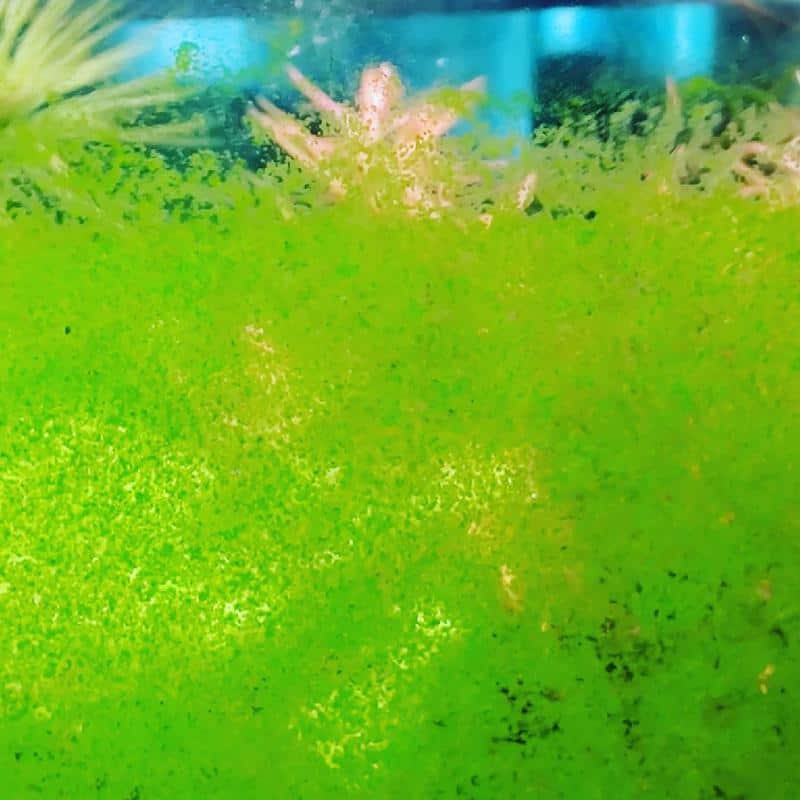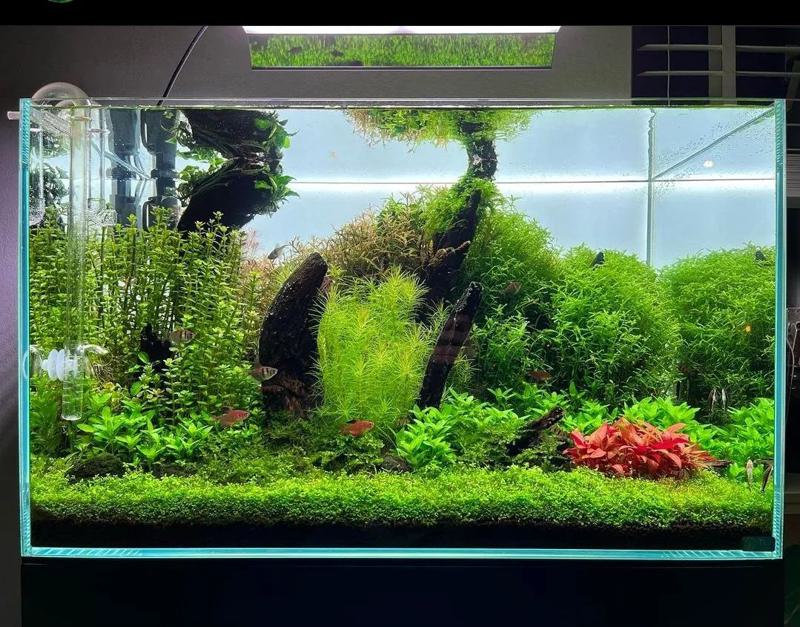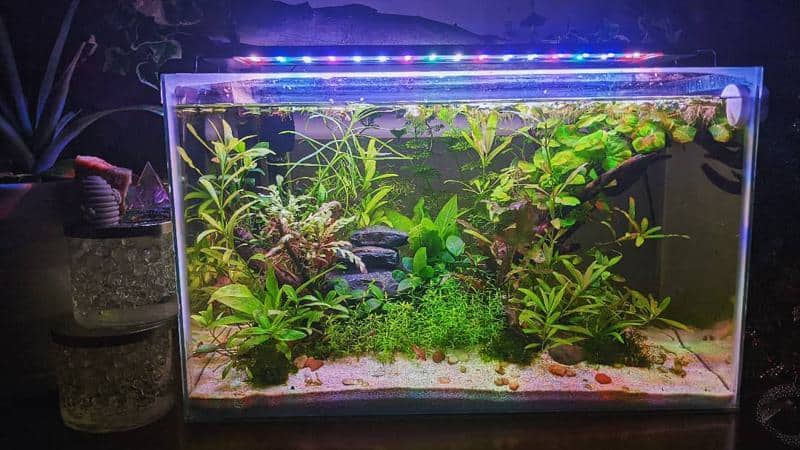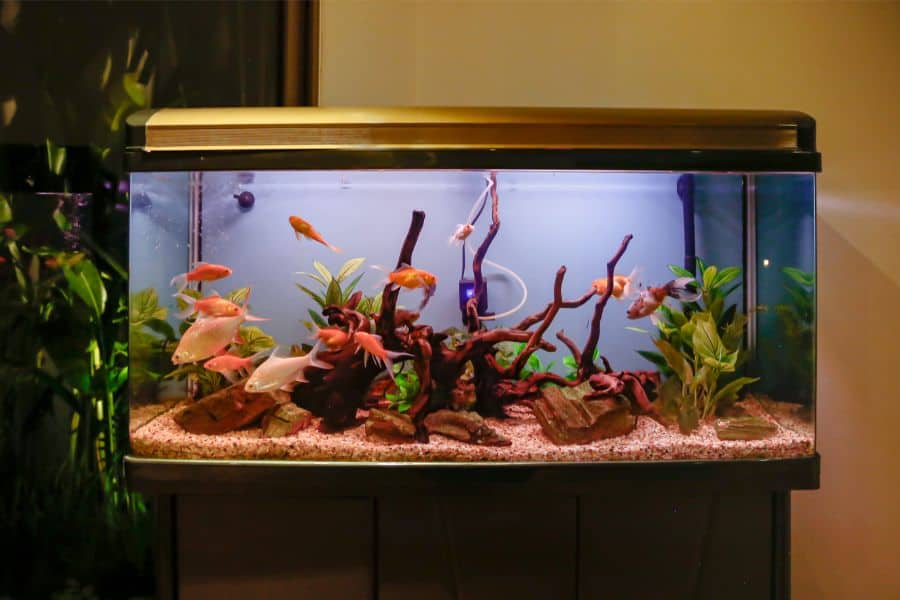We all agree that aquarium lights illuminate our tank and bring out the beauty of our fish, plants, and other tank residents.
However, we commonly disagree with and differ in practice regarding how long aquarium lights should be on. Some turn it on 24/7, others for a couple of hours at night, while some only turn their aquarium lights on when their friends are around.
For us, the length of light exposure will depend on the kind of tank and the situation, like the type of aquarium plants you are keeping or the presence of unwanted organisms such as algae.
Join us as we present in this article the recommended frequency for light exposure and the science behind using aquarium lights.
10-12 Hours Max
In the wild, aquatic organisms are attuned to sunlight during the day and darkness at night. It is their natural cycle, and adapting it in a tank setting is crucial.
Your lighting system represents the sun, and using them should provide a rhythm of light exposure that simulates sunrise and sunset.
Switch on your aquarium lights for 10 to 12 hours MAXIMUM during the day and turn them off at night until the next day. An example is from 8 am to 6 pm or 8 pm. Of course, you can always make your schedule, but what is critical is that it should coincide with your local daytime.
If your lighting system has a mode selector, we recommend you start with the low light setting for an hour or two. Remember that the intensity of sunlight is not uniform throughout the day. It is why some aquarists progress from a low to a high-light mode for 6 to 8 hours. In this way, you are simulating the peak of sunlight in the middle of the afternoon.
From peak light exposure, you shift back to a low light mode in the final hour to simulate sunset and before completely turning off your light.
The downside of this approach is you need to use a fully programmable aquarium light. Otherwise, you have to do it manually and shift between brightness modes.
If you’re using an aquarium light with a simple on/off switch, you can still automate light control with a timer. However, a timer can only control the on and off switch, not the brightness level.
The 6-Hour Initial Exposure
For newbies that do not know the habits and traits of their fish, plants, and other residents, we recommend using aquarium lights initially for 6 hours a day.
This amount of time is sufficient enough to meet the basic lighting needs of most fish and some plants.
Only some plants? Yes, since different plants need different lighting requirements, as follows:
| Type of Plant | Length of Exposure |
| Low-light Plants | 6 to 8 hours |
| Moderate-light Plants | 8 to 10 hours |
| High-light Plants | 10 to 12 hours |
Initially, when you turn your aquarium light on for 6 hours in a couple of days, you will see that low-light plants will survive and grow. However, this is insufficient for moderate to high-light plants as their leaves may fade and wither. If you see faded or withered plants, increase the length of light exposure accordingly until you reach the right time.
So, knowing what type of plant you are keeping is best so you can set your length of light exposure in advance. Also, do not worry if you reach the 12 hours of maximum exposure even if you have low-light plants since the consequence is rapid growth (a good kind of consequence).
The 4:4 Approach
We know we got your attention when we mentioned aquarium lights are switched on only during the daytime.
How about if you’re out working during the day, which most of us do? Does this mean that when you’re back home, you will stare at a gloomy-lit tank and deprive yourself of the supposed stress reliever?
No. Do not deprive yourself. Go ahead. Switch on your aquarium lights and follow the 4:4 approach. It means 4 hours during the day and another 4 hours at night. While you can do it intermittently, what we recommend is continuous.
With a timer, you can set your aquarium lights to switch on 4 hours before sunset and switch off 4 hours after sunset. An example is from 2 pm to 10 pm. Just imagine this: you are greeted with a brightly-lit aquarium when you get home at night. Stress relieved!
Signs of Too Much Light Exposure
Some beginners, especially total newbies, turn their aquarium lights on 24/7. By this time, you should be aware that every tank resident has a response when exposed to light, and there are consequences if you prolong their light exposure.
Here are some tell-tale signs of prolonged light exposure:
Rapid Algae Blooming

Algae love light. If this is the case, can you imagine how their population will explode if switching on your aquarium light is prolonged?
Initially, the condition of your tank may seem normal. However, if your water chemistry has the right nutrient amount, it can become the perfect ingredient for the algae population to bloom and grow out of control. It will come to a point where water discoloration will appear, and the thick algae density will block the light.
Expect that algae bloom directly affects all your tank residents, and mass mortality is the endpoint if you do nothing.
Related: Best Algae Eaters
Stress in Fish
Light enhances the pigment and body color of fish. However, they become stressed out when you prolong their light exposure. Remember that fish need darkness for them to rest.
The bad thing when your fish is stressed out is that their immune system becomes weak and prone to illnesses.
Fun question: Can aquarium lights provide vitamin D to your fish?
No. Vitamin D in fish is sourced from their food and stored in their liver.
While light has little impact on fish, it has the most significant effect on aquarium plants. It is why plants show the most signs of prolonged light exposure, such as:
Speedy Plant Development
Light is one of the essential requirements in growing aquarium plants. In the absence of light, your aquarium plants will not grow properly.
On the other hand, if you expose your aquarium plants to light for too long, they will continually grow, and you will be shocked at how fast they have grown in a short period.
The fast growth of plants is good. It is a desired trait preferred by aquarists. However, too much plant growth is alarming, especially in an enclosed space like your aquarium.
Stunted Plant Growth
Growing fast is not just the response of plants to prolonged light exposure, as stunted growth can also occur.
This restricted growth may happen in 2 conditions. First, low-light plants are directly affected by lengthy light exposure as their preferred habitat is gloomy. Second, when prolonged light exposure has led to algae bloom, light is blocked, reducing photosynthetic activity in aquarium plants.
Leaf Wrinkles and Discoloration
Extended exposure to light can cause the curling and wrinkling of aquarium plant leaves.
Prolonged light exposure generates more heat and causes the water temperature of your tank to increase. As a biological response to heated waters, the leaves of aquarium plants start to dry out and slowly curl up over time.
Leaf discoloration simultaneously happens as the leaves slowly dry up. From the typical green-colored leaves, it changes to either yellow, red, or brown. Of course, this is except for plants that don’t have the natural green leaves, like the Ludwigia and Rotala.
Effects of Shortened Light Exposure

The harmful effects of light are not limited to prolonged exposure, but shortened exposure also has its consequences.
Fading of Fish Color
As we said earlier, light has little impact on fish. However, in the case of shortened light exposure (especially when frequently done over time), the natural colors of your fish will fade away.
The skin of fish has chromatophores. When triggered by light, they produce new pigment cells. In effect, it makes the natural color patterns of a fish stand out. But in the event of a shortened light exposure, the production of pigment cells is reduced.
Adverse Plant Conditions
Your aquarium plants will not grow if you trim down their exposure to light. Likewise, shortened light exposure will have the same effects as obstructed light by the blooming of algae.
So, when you shorten the light exposure of your aquarium plants, expect their leaves to curl, discolor, and wither. What’s worse, the whole plant will start to rot due to less photosynthetic activity.
Here’s a summary of the effects on shortened and prolonged light exposure.
| Effects | Shortened light exposure | Prolonged light exposure |
| Stress in fish | ✓ | |
| Fading of fish color | ✓ | |
| Rapid algae blooming | ✓ | |
| Speedy plant development | ✓ | |
| Stunted growth | ✓ | ✓ |
| Leaf wrinkles / discoloration | ✓ | ✓ |
How to Prevent the Adverse Effect of Aquarium Light
Shortening or prolonging the exposure of your fish and aquarium plants has adverse effects but can be prevented.
You need to follow the recommended length of light exposure. Aside from this general recommendation, you can do the following:
Use the Proper Type of Light

Technological advancement has paved the way for manufacturing several bulbs used in aquarium lights: incandescent, fluorescent, metal halide, and LED.
Incandescent
This type of bulb used as an aquarium light is one of the oldest. For a moment, incandescents were discouraged since they emit too much heat. But now, it is slowly coming back with a new version.
From typical yellow bulbs before, new incandescents come in a glo version that produces a red-blue spectrum and is great for illuminating small tanks.
Fluorescent
Fluorescent bulbs were commonly used in the 80s and 90s. Some aquarists still use them up to this day since they can fit and serve a variety of tank sizes.
While more compact than incandescents, they still produce heat, making it a downside trait of this type of lighting system.
Metal Halide
Aquarium lights using metal halide bulbs are often the choice of aquarists in illuminating deeper and wider tanks.
While it seems they are the perfect type of light, be aware that they still emit heat like incandescents and fluorescents do.
LED
Of all the types of aquarium lights, the least that emits heat are the LEDs. They are compact, lightweight, and have accessories for automation, making them the preferred aquarium light in today’s aquarium hobby.
Provide the Appropriate Wattage
Regardless of the type of bulb you will use, all of them have a watt rating. Watt specifies the rate at which energy radiates. More wattage means more solar energy emitted.
But this does not mean you will use a higher watt for your tank to get the most brightness. The recommended illumination for an aquarium setup is as follows:
| Type of tank | Recommended wattage |
| Low-light | 1 to 2 watts per gallon of water |
| Moderate-light | 3 watts per gallon of water |
| High-light | 4 watts per gallon of water |
Install an Aquarium Lid
Installing an aquarium lid or cover serves two purposes. First, it serves as heat retention. The heat produced by your bulb will not go directly to the water. Second, it protects your lighting system from moisture buildup, preventing electrical short circuits from happening.
Also Read:
FAQs
What Happens if I Turn My Aquarium Light 24/7?
Obviously, your electrical bill will increase. Kidding aside, switching on your aquarium light 24 hours a day will create a totally new environment for your fish and plants. Remember that aquatic organisms need a period of darkness to trigger their resting period.
Expect your fish to be totally stressed out if you turn on your aquarium lights 24/7. The lights will give them no time to rest and they will get exhausted in the long run. As for plants, it can be beneficial to them initially. However, your waters will warm up and promote the blooming of algae. In other words, what you will be keeping in the long run are algae and not your aquarium plants.
How Long Should I Keep Lights Off for New Fish?
Newly kept fish need time to adjust to their new home. Placing them directly in an intensely-lit tank will stress them out. Proper acclimation in fish when it comes to light is to set it initially at low mode for a few hours.
In a low light mode, you will see your fish taking refuge at your plants, decorations, or just at the corner of your tank. But since your tank is dimly-lit, it will be enticed to explore out, which in turn, facilitates the acclimation process.
Once you see your fish is acclimated, you can slowly increase back the light intensity.
What Are Other Units to Measure Light Intensity?
Aside from watts (which we already described), kelvin, lumens, and PAR (Photosynthetically Active Radiation) are used to measure aquarium light intensity.
Kelvin is used for color temperature. The lower the rating, the warmer the color. On the other hand, the higher the rating, the cooler the color output. As a benchmark, sunlight has a rating of 5500 Kelvin.
Here’s a simple guide for aquarium applications using the Kelvin rating:
| Type of tank | Kelvin rating |
| Fish tank | 5500 to 6500 |
| Planted tank | 6500 to 7500 |
Lumens are brightness perceived by the human eye. The more the lumens rating, the more bright it is for the eyes.
PAR is a specific type of light radiation used in growing plants and beneficial algae. Here’s a simple guide on the proper PAR usage:
| Type of tank | PAR rating |
| Low-light | 15 to 30 |
| Moderate-light | 30 to 80 |
| High-light | 80 or more |
| Reef tank | 300 to 500 |
Conclusion
Now that you know how long aquarium lights should be on is dependent on the situation, you can now review your setup and assess if you are doing it the right way.
After all, aquarium lights are not just used to glow and bring out the beauty of your tank and impress your friend. They serve a function and use it properly to your advantage.
